|
Displaying items by tag: New York

Picasso Black and White opened earlier this month at the Guggenheim Museum in New York. The first major exhibition to focus on the artist’s lifelong exploration of a black and white palette features 118 painting, sculptures, and works on paper spanning from 1904 to 1971. Five of the works have never been exhibited or published and another thirty-eight works have never been on view in the U.S.
The Guggenheim exhibition has received plenty of praise since its opening but there is one painting in the show that is unlike the others. Woman Ironing (La Repasseuse) is a quintessential image of the disenfranchised people Picasso focused on during his Blue Period (1901–1904). Painted at the tail end of the period, the white and gray palette creates a tired, bleak atmosphere for the frail woman who stands hunched over her iron. But there is something beyond this gloomy woman.
Picasso painted Woman Ironing while he was a struggling artist in his 20s. For economy’s sake he reused an old canvas that he had already used for the beginnings of a portrait of man with a mustache, which he later abandoned. In 1989 an infrared camera detected the presence of the man underneath Woman Ironing. Advances in x-ray and infrared technology have allowed a clearer image of the mysterious mustachioed man and scholars, curators, and conservators have various theories as to who he is. Suggestions include Richard Canals, a rival artist and friend of Picasso, Mateu de Soto, a sculptor with whom Picasso shared apartments and studios with, and Benet Soler, a tailor who was one of Picasso’s oldest friends. Some theories suggest the man with the mustache was one of Picasso’s early self-portraits.
Black and White and Woman Ironing will be on view at the Guggenheim through January 23, 2013.
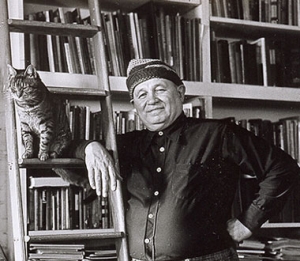
Romare Bearden: The Paper Truth opens October 24 at the 92nd Street Y’s Milton J. Weill Art Gallery in Tribeca. Featuring 44 works on paper by Romare Bearden who is best known for his expressive depictions of African-American life, the exhibition includes watercolors, collages, and mixed media pieces.
The Paper Truth wouldn’t be possible without Russell Goings, a longtime friend of Bearden. The two met in the late 1960s when Goings was the chairman of the Studio Museum in Harlem and Bearden was a member of the institution’s board. The two struck up a friendship that resulted in Goings’ impressive collection of hundreds of Bearden’s works, some that he bought from Bearden and some he received as gifts from the artist.
The exhibition includes a self-portrait that Bearden made just days before his death in 1988 at age 75. Drawn on a page from a book of Jewish mysticism, the works has never been shown publicly. Two series, The Odyssey and The Historical Figures are also part of exhibition. Bearden made several versions of The Odyssey but the 22-piece series being shown has not been displayed in its entirety in New York in over thirty years. The Historical Figures series, a small collection of portraits of people of all races who helped to shape African-American history, has never been exhibited in New York.
The exhibition, which is on loan from the collection of Russell Goings and Evelyn Boulware (Goings’ longtime companion), will be on view through December 9.

The Huntington Library, Art Collections, and Botanical Gardens acquired thirteen pieces of furniture by the American architect, Frank Lloyd Wright. The selection of furniture had previously been on display at the Library since 2009 as part of a long-term loan from the prominent New York collectors, Joyce and Erving Wolf. The purchase was made directly from the Wolfs for an undisclosed amount.
The highlight of the group is a nine-piece dining room suite designed in 1899 for the now-demolished Husser House in Chicago. The commission marked a turning point in Wright’s career as he moved away from his more architecturally rigid views on interiors towards the notion that interior space can be open and flowing. The other four pieces in the acquisition were from signature Wright houses in Illinois including the Avery Coonley House, the Arthur Heurtley House, the Little House (which has been demolished), and the Ward W. Willits House.
One of the greatest architects of the 20th century, Wright played a pivotal part in changing design sensibilities from the highly ornate styles of the late-19th century to more streamlined designs for modern times. In addition to developing plans for upward of a thousand buildings, Wright designed furniture, leaded-glass windows, light fixtures, metal ware, and textiles – all made to harmonize with the buildings for which they were intended.
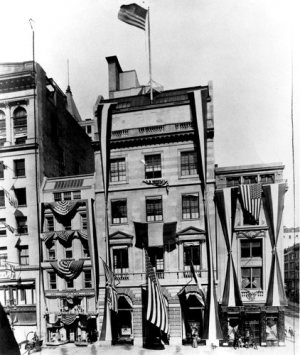
165 years ago, the Knoedler Gallery opened its doors in New York and went on to help create some of the country’s most celebrated collections including those of Paul Mellon, Henry Clay Frick, and Robert Sterling Clark. Throughout the years, top-notch works by artists such as van Gogh, Manet, Winslow Homer, John Singer Sargent, Louise Bourgeois, and Willem de Kooning passed through the gallery. When the Soviet government sold hundreds of paintings from the State Hermitage Museum in Leningrad in the 1930s, they chose to work with Knoedler to sell paintings by masters like Rembrandt, Raphael, and Velazquez.
Knoedler’s exemplary past is often forgotten as the gallery’s present has been mired in lawsuits and accusations that the company’s former president, Ann Freedman, was in the business of selling fakes. Last year, Knoedler Gallery closed its doors for good.
This week, Los Angeles’ Getty Research Institute announced that it had bought the Knoedler Gallery archive. Spanning from around 1850 to 1971, the archive includes stock books, sales books, a photo archive and files of correspondence, including letters from artists and collectors, some with illustrations. The Getty was interested in Knoedler’s archive because it offers an expansive glimpse into the history of collecting and the art market in the United States and Europe from the mid-19th century to modern times.
The archive was purchased from Knoedler’s owner, Michael Hammer, for an undisclosed amount. Meticulously preserved, the archive will be available to scholars and digitized for online research after the Getty catalogues and conserves it all.

In 1961, art dealer Leo Castelli bought a painting by Roy Lichtenstein for $750. One of the founding fathers of Pop Art, this particular piece was one of Lichtenstein’s first. In 1970, when Castelli sent the painting to be cleaned by art restorer, Daniel Goldreyer, he didn’t know it would be the last anyone would see of the work for a long time.
Goldreyer soon contacted Castelli to tell him that Electric Chord had gone missing from his office. Efforts to locate the painting went on for decades. The Roy Lichtenstein Foundation even put an image of the work on its holiday greeting card in 2006 to remind people of the ongoing search. This past July, Electric Chord turned up in a storage facility in New York. Goldreyer’s widow had found the painting in a locker belonging to a former employee after her husband’s death in 2009. Ms. Goldreyer tried to sell the painting to Quinta Galeria in Colombia using an assumed name. She claimed she was selling it on behalf of a friend. The gallery decided to send the work back to New York.
Leo Castelli’s widow, Barbara, picked up Electric Chord on Tuesday, October 16th. Valued at $4 million, she plans to hang the painting in her home.
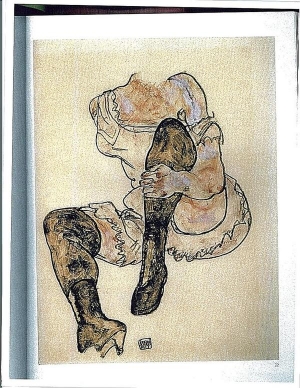
On October 11, the Second Circuit Court of Appeals decided that the current owner of Egon Schiele’s Seated Woman with Bent Left Leg (Torso) could keep the drawing he purchased in the early 1960s from a gallery in Manhattan. Featuring the artist’s signature muted color palette, the work has been at the center of a seven-year-long legal battle.
The dispute arose when heirs to Fritz Grunbaum, a Viennese cabaret singer who was murdered by Nazis in 1941, claimed that the work had been unlawfully confiscated from Grunbaum’s estate in 1938. Although David Bakalar currently owns the drawing, Grunbaum’s heirs, Milos Vavra and Leon Fischer, considered themselves to be the rightful proprietors. When Bakalar attempted to sell Seated Woman at Sotheby’s London in 2004, Vavra and Fischer stopped the sale. Bakalar, who had bought the Schiele drawing from Galerie St. Etienne for about $3,300, was attempting to sell the work for about $675,000.
Although Grunbaum was a noted collector of Schiele’s work, there was no direct evidence that he had owned Seated Woman or that Nazis had confiscated the drawing. However, evidence emerged that Grunbaum’s sister-in-law, Mathilde Lukacs, sold the drawing in Switzerland in 1956. The Swiss dealers who had purchased the drawing from Lukacs testified in the case and provided records of the sale. Based on this evidence, the U.S. District Court ruled that Grunbaum was most likely not the drawing’s owner and that Nazis had not stolen the piece, rather, it had stayed with the family until the sale in 1956.
The Court’s ruling was particularly significant because Bakalar had employed New York’s “laches defense,” a defense that is used by good-faith buyers to protect themselves against frivolous claims. While Schiele’s heirs claimed that if Lukacs had owned the drawing it was because she had stolen it from Grunbaum, Bakalar argued that the fact was irrelevant because no claims had been filed and that crucial evidence had disappeared over the decades.
The inaugural Frieze Masters fair is already drawing comparisons to TEFAF Maastricht, the pinnacle of Old Masters fairs that takes place annually in the Netherlands. Featured alongside the contemporary art world staple, the Frieze Art Fair, Frieze Masters has been watching the sales add up.
Highlights include a Louise Bourgeois bronze, Avenza Revisted (1968–69), that was sold by New York’s Cheim & Reid gallery for $1.5 million, Bruce Nauman’s installation, Parallax Shell (1971), along with the drawing for it, which was sold by Sperone Westwater (New York) for $2–3 million, and Pablo Picasso’s Homme et Femme au Bouquet (197) which brought in around $9 million during the fair’s preview thanks to Wan de Weghe Fine Art (New York).
Concluding on October 14, Frieze Master still has plenty of time to keep the sales coming.

While sales totaled $3,486,127 million at Sotheby’s American Paintings, Drawings, and Sculpture auction on September 28th in New York, 35% of lots went unsold. Sotheby’s did slightly better than Christie’s in the American Art arena, but both sales are a testament to the lackluster performance of mid-season auctions.
“Sotheby’s did put a few more important paintings in the sale,” said Debra Force of Debra Force Fine Art, Inc. “The question is whether the clientele is there to buy it.” It appears that the clientele interested in purchasing Rockwells were at least in attendance. Is He Coming? (1919), a quintessential Norman Rockwell painting of a young boy and his dog peering up the chimney on what appears to be Christmas Eve, brought in $602,500. The final price was $300,000 more than than the paintings high estimate ($200,000–$300,000).
Sotheby’s sale featured more than 200 paintings, drawings, and sculptures and included property from two noteworthy private collections belonging to Margie and Robert E. Petersen and Susan Kahn Rosenkranz and Richard Rosenkranz. Highlights included works by Rockwell Kent, Marsden Harley, Grandma Moses, and Ben Shahn with Kent and Moses taking two of the top five lots. Moses’ On the Banks of the Hudson reached the third highest price of the sale at $92,500 but still brought in considerably less than its high estimate of $120,000. Rockwell Kent’s Adirondack Farm, Summer sold for $86,5000 (estimate: $25,000–$35,000), the fourth highest sale of the auction.
While the highlights of the auction could have made more money in a more important sale, the quality is there. "Maybe more important collectors need to get used to looking at these mid-season sales," says Force.
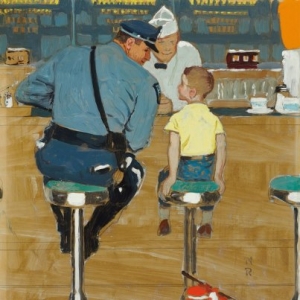
Held in New York on September 25th, Christie’s American Art sale counted two Norman Rockwell works on paper as the top lots. Study for ‘The Runaway,’ perhaps the artist’s most iconic image, brought in $206,500. The original estimate for Study at auction was $80,000–$120,000. In 1958, the completed work, which features a young boy at a diner in conversation with a policeman, was used as a Saturday Evening Post cover.
The other Rockwell that fared well was Keeping His Course (Exeter Grill) which had an estimate of $100,000 to $150,000 and ended up selling for $218,500. The work was originally conceived as an illustration for the book Keeping His Course (1918) by Ralph Henry Barbour. A less recognizable Rockwell, A Man’s Wife, didn’t quite reach it’s $30,000–$50,000 estimate and ending up selling for $27,500.
Edgar Alwin Payne’s Western painting La Marque Lake, High Sierra more than doubled its $25,000–$35,000 estimate when it sold for $80,500. Other works that exceeded expectations were Andrew Wyeth’s watercolor, Front Door at Teel’s (estimate: $50,000–$70,000), that realized $93,700 and Josef Mario Korbel’s Andante (Dancing Girls) (estimate: $30,000–$50,000), a bronze that brought in $62,500.
The auction offered over 160 lots including Impressionist and Modernist works, Western pieces, illustrations, and bronzes. Artists on the block included Stuart Davis, Milton Avery, Will Barnet, Edward Hopper, and William Merritt Chase. Expected to reach in excess of $2.5 million, the total sale realized for the auction was $2,649,475.
While the auction reached its estimate, only 63% sold by lot and 76% by value. Debra Force of Debra Force Fine Art, Inc. said, “63% is terrible but there are many reasons for the poor performance. September is too early in the season for a sale. People are just getting back from summer, putting kids in school, and it’s in the middle of the Jewish holidays.” Force added, “The important collectors don’t look at these mid-season sales. They should, but they’re waiting for the major sale.“
Gavin Spanierman of Gavin Spanierman Ltd. echoed Force’s sentiments. “63% is pretty scary if you’re a seller but that’s representative of mid-season sales. However, the fact that the two Rockwells did well considering they were not phenomenal, shows that there is strength in the market.”
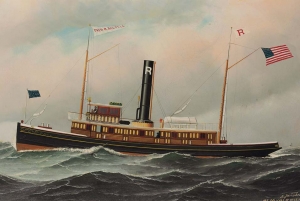
On September 24th, Christie’s presented their American Furniture, Folk Art, and Decorative Arts Sale in New York. Spanning the 18th and 19th centuries, works included furniture from the Wunsch Americana Foundation, the Philadelphia Museum of Art, and American folk art and maritime paintings. The sale was 85% sold by lot and 93% by value.
The top lot was a Chippendale carved mahogany easy chair that was entrusted to Christie’s by the Philadelphia Museum of Art. Estimated at $600,000-$900,000 and attributed to the renowned yet mysterious Garvan carver, the chair brought in $1.16 million, the third highest price ever paid for the form. “We are thrilled to have been the successful bidders on the Garvan Carver easy chair. It is a wonderful chair,” said Todd Prickett of C.L. Prickett who specializes in American antiques. The Museum will use the funds for new acquisitions.
Another lot that brought in more than expected was a Queen Anne Japanned Maple Bureau Table. One of about forty known examples of japanned furniture from colonial America, it is the only bureau table known to exist. Estimated at $60,000-$90,000, the table sold for $98,500.
Two paintings by the maritime artist, Antonio Nicolo Gasparo Jacobsen (1850–1921), sold for more than their estimates that ranged from $12,000 to $18,000. The Paddlewheel Steamer St. John went for $45,000 while Fred B Dalzell went for $25,000.
Not all lots did as well as anticipated. A pair of Federal eagle-inlaid mahogany side chairs attributed to William Singleton were estimated at $60,000 to $90,000 but only sold for $32,500. The pair of chairs had been lent to the Diplomatic Reception Rooms at the Department of State in 1968 and remained in the Monroe Reception Room as part of a larger set of four related chairs until they were returned to the Wunsch Americana Foundation. Until know, the location of this particular pair was unknown.
|
|
|
|
|